Exclusive: Huntkey FX500SE in Europe
Kapitoly článků
Measurements of the +5 V SB
All measurements are taken in accordance with the actual version of testing methodology (czech only). The +5 V SB rail in the Huntkey FX500SE passed all types of load without any problem.
| Power output (W) | Load (A) | Voltage (V)/ ripple (mV) | Power drain (W) | Efficiency/power factor |
| 0 | 0 | 5,01/6,40 | 0,4 | -/0,02 |
| 11,75 | 2,37 | 4,97/4,75 | 15,3 | 76,8 %/0,42 |
| 16,51 | 3,34 | 4,95/5,40 | 20,7 | 79,8 %/0,48 |
Actually, the rail not only passed the loading, it passed with extraordinary results. Ripple is very low as usually, but the voltage varied only 1 % even at 34% overload. The efficiency also at (almost) maximum (nominal) output overpassed the platinum and so far the best, Fractal Design Newton R3 600 W (czech only). Under the overload scenario, it even - as I suggested - attacked the 80% line, only few tenths were missing. For all this I add two extra points.
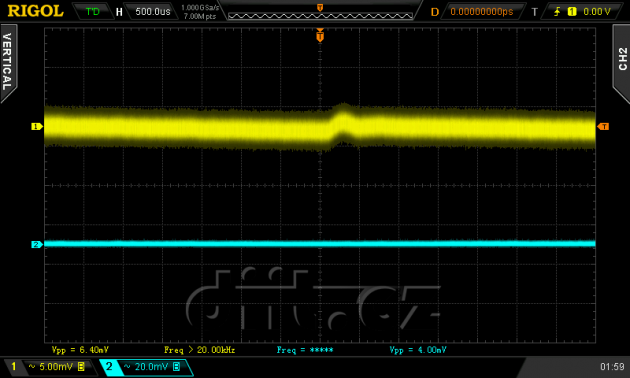
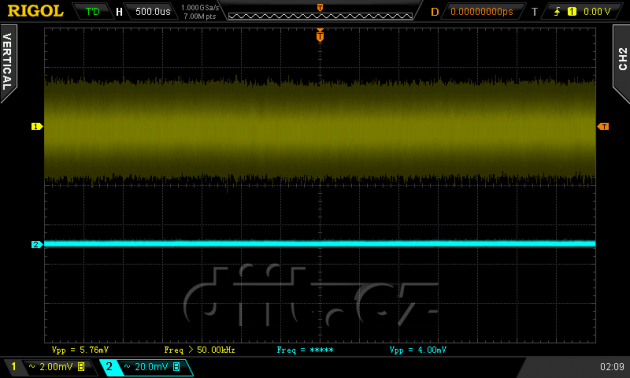
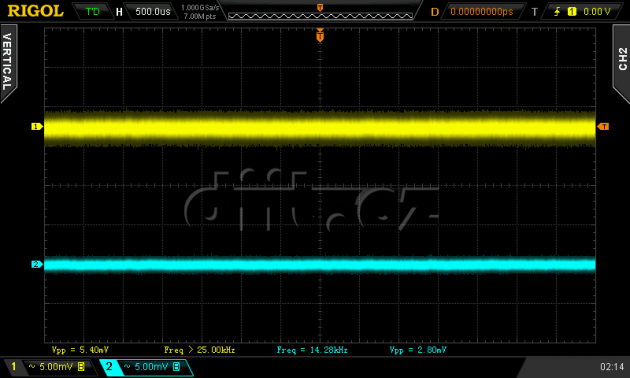
Ripple at +5 V SB, from left: 0 A, 2,37 A, 3,35 A
I also measured the temperatures after 25 minutes of overloading. They did not overstepped 50 °C on the PWM IC and 80 °C on the secondary rectifier. It is not particularly low, but the temperature will not be as high under the nominal load. Even than, I would suggest Huntkey to add at least a small piece of aluminium or maybe extend the secondary heatsink and mount the rectifier there. That may even help to overcome the 80 % efficiency line.
Combined load measuements
I have more (than usually) aimed at loading the +12 V rail because of the fact here are DC-DC modules used (instead of group regulation) and there is almost no need to load the other rails. It is actually consistent with the new motherboards draining only more and more neglectible amounts of power from +3,3/+5 V rails for memory and other devices. That means almost all the power is drained from +12 V. Also the combined output power here is very small on the +3,3 and +5 V rails, 90 W. Anyway, I have to admit, it was almost pleasing to measure this power supply…
| Power output | Load/ voltage+5 V SB | Load/ voltage +3,3 V | Load/ voltage +5 V | Load/ voltage +12 V | Load/ voltage -12 V | Power drain | Efficiency/power factor | Temperature intake/outtake |
| 5,7 %/ 28,53 W | 0 A/ 5,00 V | 0 A/ 3,33 V | 0,28 A/ 5,08 V | 1,94 A/ 12,35 V | 0,28 A/ -11,60 V | 33,6 W | 84,9 %/ 0,62 | - °C/ - °C |
| 20 %/ 104,82 W | 0,46 A/ 4,98 V | 2,96 A/ 3,33 V | 0,31 A/ 5,07 V | 7,11 A/ 12,32 V | 0,30 A/ -11,69 V | 117,4 W | 89,3 %/ 0,92 | - °C/ - °C |
| 40 %/ 195,42 W | 0,99 A/ 4,97 V | 4,33 A/ 3,32 V | 2,13 A/ 5,06 V | 13,20 A/ 12,30 V | 0,27 A/ -11,81 V | 213,1 W | 91,8 %/ 0,99 | - °C/ - °C |
| 60 %/ 294,45 W | 1,43 A/ 4,95 V | 4,45 A/ 3,31 V | 3,33 A/ 5,05 V | 20,60 A/ 12,26 V | 0,28 A/ -11,99 V | 326,1 W | 90,3 %/ 1 | - °C/ - °C |
80 %/ 396,89 W | 1,94 A/ 4,93 V | 5,94 A/ 3,30 V | 4,72 A/ 5,03 V | 28,05 A/ 12,23 V | 0,29 A/ -12,19 V | 440,5 W | 90,1 %/ 1 | 30 °C/ 38 °C |
| 100 %/ 492,86 W | 2,42 A/ 4,92 V | 7,49 A/ 3,29 V | 6,59 A/ 5,01 V | 34,33 A/ 12,21 V | 0,34 A/ -12,39 V | 545,9 W | 90,3 %/ 1 | 30 °C/ 38 °C |
Almost because of the fact it still lacks slightly better regulation of the +12 V rail. There is slightly higher initial voltage with 2,9 % variation but it slowly falls under 2 %, to 1,18 % to be specific. It is important to say that higher voltage is better than lower (that means better 12,2 V than 11,8 V), all the VRMs for CPUs and GPUs have lower current load and higher efficiency thanks to that. On the other hand, the voltage regulation of the +3,3 V rail is just extraordinary, the variation was lower than 1 %. The +5 V and +5 V SB rails were not much worse, both have not crossed 2 %, -12 V had it's worst result around +-3 % (where ATX specification allows +-10 % and I allow +-4 %; for positive voltages +-2 %). The platinum Newton R3 is worse regarding all these other rails (than +12 V).
The efficiency alone is amazing, starting at almost 85 % and keeping over the 90 % barrier till the very end. It does not have as high maximum as Newton R3, but the minimum is higher and starting with 20% load, it is more linear, reaching 90+ % all the time. I also have to remind that I am talking about 600W vs. 500W supply (and generally, efficiency of high-power PSUs is better). The fan stayed off all the way up to (and including) 60% load and started spinning slowly somewhere between 60 % and 80 % load. I give whole two points for this.
Ripple
If I was to compare the ripple with the Newton R3 once again, it is one decimal place higher (Newton R3 has just incredibly low ripple). But it really grows too high on the +5 V rail here, all the way to 58,4 % (which passes my demands for mainstream, but not high-end). On the other hand, ripple on the -12 V rail is halved, similarly good results have been achieved only by Fortron FSP500-60GHN(85) (czech only) so far.
| Power output % | Ripple +5 V SB | Ripple +3,3 V | Rippleí +5 V | Ripple +12 V | Ripple -12 V |
| 5,7 | 15,0 mV | 10,4 mV | 13,4 mV | 11,0 mV | 27,6 mV |
| 20 | 21,2 mV | 15,2 mV | 16,4 mV | 17,6 mV | 29,2 mV |
| 40 | 27,2 mV | 18,4 mV | 18,4 mV | 18,2 mV | 24,8 mV |
| 60 | 24,4 mV | 18,8 mV | 24,4 mV | 17,2 mV | 29,2 mV |
| 80 | 25,6 mV | 19,2 mV | 26,8 mV | 16,8 mV | 34,0 mV |
| 100 | 26,4 mV | 15,2 mV | 29,2 mV | 25,2 mV | 33,2 mV |
The ripple at +3,3 and +12 V is very nice, anyway, the FX500SE will loose some points here because of the already mentioned +5 V rail. Here, using the X-CON ULR capacitors with higher capacity may help, this line offers much higher capacitance than what is used in the same can size.
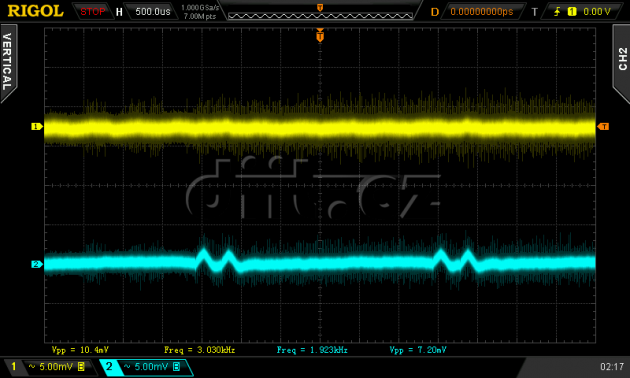
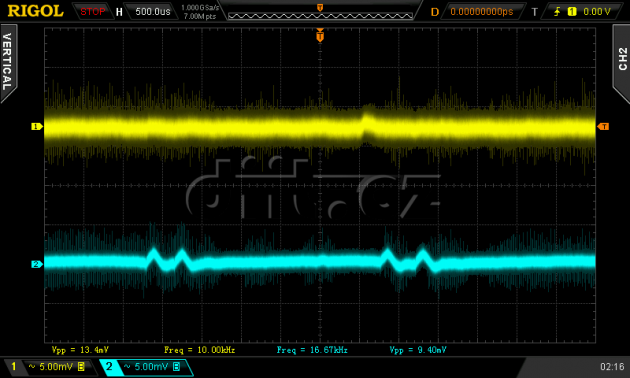


Ripple at 5,7% load; second channel is connected to +12 V the whole time
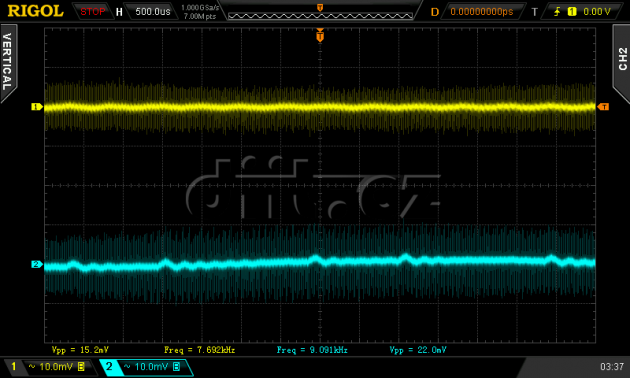

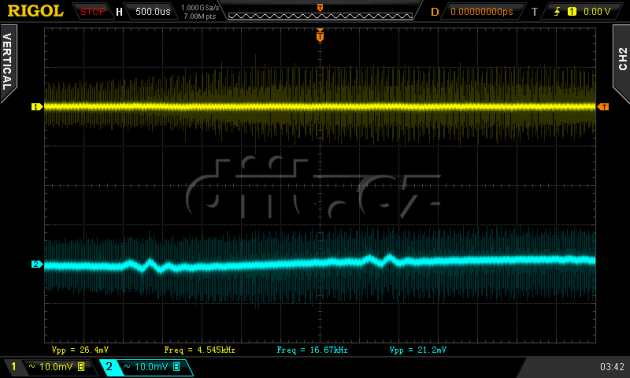

Ripple at 100% load; second channel is connected to +12 V the whole time
Crossloading, overloading
No problems were met during the crossloading scenario. The +12 V rail had even lower variation from nominal, 2,75 %, all the other rails achieved better results as well. The supply was still running in passive mode but the efficiency with +3,3 V crossload was bad, it dropped all the way to 82 %.
| Power output | Load/ voltage+5 V SB | Load/ voltage +3,3 V | Load/ voltage +5 V | Load/ voltage +12 V | Load/ voltage -12 V | Power drain | Efficiency/power factor | Temperature intake/outtake |
| 26 %/ 131,80 W | 0,48 A/ 4,97 V | 1,59 A/ 3,31 V | 20,15 A/ 4,97 V | 1,75 A/ 12,32 V | 0,21 A/ -11,77 V | 149,7 W | 88,0 %/ 0,96 | - °C/ - °C |
| 20 %/ 97,62 W | 0,57 A/ 4,98 V | 19,64 A/ 3,30 V | 1,28 A/ 5,06 V | 1,63 A/ 12,33 V | 0,29 A/ -11,70 V | 118,6 W | 82,3 %/ 0,92 | - °C/ - °C |
| 121 %/ 603,05 W | 3,34 A/ 4,89 V | 4,13 A/ 3,28 V | 7,96 A/ 5,02 V | 43,50 A/ 12,17 V | 0,30 A/ -12,73 V | 694,0 W | 86,9 %/ 1,00 | 30 °C/ 42 °C |
I managed to overload the whole supply up to 121 %. All the protections work fine, loading the +3,3 V over 21 A and +5 V over 23 A turned the power supply off. The efficiency dropped very sligthly under Platinum requirements at 86,9 %.
Ripple
The crossloading ripple was much better than in the case of combined loading. Worst case was when the +5 V rail achieved 40 % of the ATX specification, here the Huntkey FX500SE will get basic points income.
| Power output % | Ripple +5 V SB | Rippleí +3,3 V | Ripple +5 V | Ripple +12 V | Ripple -12 V |
| 26 | 16,4 mV | 18,0 mV | 20,0 mV | 12,4 mV | 25,2 mV |
| 20 | 18,0 mV | 16,8 mV | 19,6 mV | 14,4 mV | 32,0 mV |
| 121 | 25,2 mV | 16,4 mV | 22,0 mV | 45,6 mV | 30,0 mV |
When overloading, the ripple at +12 V increased three times which is still under 40 % (38 % precisely) so it is good than Huntkey did not leave the FX500SE go any further.






















